Authors
Heir of Light, full cover
Comment on Worldbuilding Articles: 2025 Reader Poll Results by Cindy Houghton
I had hoped the ‘Sigl Fashion’ option would have scored higher… I figured with the nobility and ultra wealthy type of folks, sigl jewelry would almost reach a ‘crown jewels’ sort of function. You become head of house, or the heir apparent, you get something like a signet ring, like the official ducal seal worked into the ring Paul inherits from his father as Duke Atreides in Dune. Or the signet ring Hadrian wears in the Sun Eater series, as a sign of his status and rank as a Palatine. The King still wears the three feather signet ring of Wales, like he did as Prince of Wales. The new heir or head of house would get the ring, just getting a new sigl created and mounted in the antique setting.
Also, I figured with the younger crowd and the fact some sigls need to be worn close to the skin, that sigl jewelry piercings would be more widespread than they apparently are in the series so far.
DOGE- Supernatural Division (episode 4)
It’s Hughday Again! Chapter 3
Thank you for kind comments and support this week. Usually we post scene by scene, but today we will do the whole chapter.

Hugh stepped out of the woods and started up the road to Baile. The old castle rose atop the low hill like some ancient fort built by a Norman knight intent on keeping all he surveyed clenched in his iron gauntlet. It had been born in England, then transported stone by stone to Kentucky and reassembled on a whim of a man with too much money. The Shift had restored its original purpose. It was both a fortified base and a symbol of power.
He once told Elara that the point of the castle wasn’t to hide within the walls but to be worthy of it. The man who controlled the castle controlled the lands around it.
He needed to be that man. Not because he wanted the headache but because maintaining control of their immediate surroundings was the only path to safety. They were too far from any regional authorities, and in the great scheme of things, his fighting force was laughably small. By the latest count he had 348 Iron Dogs. During his time as Roland’s warlord, he commanded 2,400 trained soldiers. Almost seven times what he had now.
The familiar rage shivered deep inside him, hot and angry. He had built the most elite force on the continent and Roland had dismantled it out of cowardice.
Hugh pushed it aside. He needed a cool head for what waited ahead.
Aberdine presented a problem. The small town controlled the only leyline point within twenty five miles. The magic current was the fastest and safest way to reach Lexington or any of the other cities, and Baile depended on trade. Herbs, cosmetics, medicine, all of that flowed out through the leyline and returned as cash and supplies. In the past, Aberdine proved less than cooperative, despite relying on Baile’s medical supplies and booze.
Given a choice, he would have done whatever he could to take charge of Aberdine. In the old days, when Roland’s magic seared all doubt, guilt, and compassion from his mind, he would’ve set the town on fire, built a fort on the ashes, and put a detachment of Iron Dogs into it.
Those days were behind him now. He was a different man, less powerful, without immortality or backing of Roland’s magic, but he had his freedom. It was hard won. He could still feel the void, swirling on the edge of his consciousness, ready to sink its teeth into him if he faltered.
He was also married and charged with defending about 5,000 civilians who depended on his protection and ability to negotiate. The fact that Aberdine sent someone over and asked to see him meant both would be required.
His lovely wife was waiting for him by the castle gates. She wore a light lilac dress today, and her white hair, gathered into a plait, wrapped around her head like a crown.
He’d half expected her to have been deep in negotiations with whoever Aberdine sent. For some reason, he was happy that she waited for him.
Hugh walked through the gates. She gave him a weary look.
“I heard we have guests,” he said.
“Nick Bishop and two others,” she said.
She looked like something had been eating at her. It bothered Hugh.
“Where are they?” he asked.
“Waiting inside.”
They started toward the keep, walking side by side. The bailey was crowded with people hurrying back and forth. A team of villagers hung fall garlands on the walls. Another trio had brought a cart filled with bright orange pumpkins and were now arguing over the most picturesque location to position it while an old pinto horse patiently waited for them to make up their minds. A gaggle of tweens carried baskets of chestnuts. The castle was getting ready for Harvest Day.
“What do you think they want?” Hugh asked.
“I don’t know, but Bishop’s arm is in a sling and the other two have bruises on their faces. Whatever it is, it can’t be good.”
Nick Bishop was Aberdine’s chief of police, National Guard Sergeant, and Wildlife Response Officer, all of which put him in charge of the same six people. He’d met Bishop during the battle of Aberdine. The man kept a cool head and was capable.
If Bishop had showed up, Aberdine had a problem. One that required an Iron Dog kind of solution. This wasn’t about herbs or beer. This was about violence.
Ah. “So it’s that kind of visit, then.”
Elara didn’t respond. She was walking fast, her gaze dark, her lips a thin firm line.
“The herbs?” he guessed.
“That too, but mostly it’s Aberdine.”
They entered the main keep and Elara turned left, down the hallway leading to the visitor room. He remembered it well. When he first came to Baile a few months ago, half-starved and only barely sane with the void gnawing on his soul, she’d put them in that room. And then she made them sit in there, smelling delicious bread baking in the kitchen for half an hour before she came to negotiate.
“What about Aberdine?”
“They sent their Chief of Police. They’re going to ask you for help. They’re going to expect you to take the Iron Dogs, leave the castle, go source alone knows where, and fight.”
“That’s what people usually want from me.”
She stopped and turned to him. “I don’t want you to go.”
Interesting. “I seem to remember a certain woman who demanded that I drop everything and take our troops to defend Aberdine not that long ago. And when I argued against it, she tried to shame me by pointing out that Aberdine was full of babies.”
She raised her head. “That was then and this is now.”
“I’m going to need a little more than that.”
Elara sighed. “Then Aberdine was about to be wiped off the face of the planet. You saved them because it was the right thing to do. But now, since Aberdine survived, they should have the decency to handle their own problems.”
“That depend on the type of problem. There will be times when Aberdine’s issues could become ours.”
“And that’s exactly what I don’t want. I don’t want you getting hurt, I don’t want any of our people getting hurt, and I don’t want to take in anymore of their people. I just want to celebrate Harvest Day in peace. I’ve had enough of blood and gore.”
Ah. He got it now. For him, blood and gore were business as usual. The battle with Nez, terrible as it had been, was just another fight. He had personal stakes in that one, and he’d almost died, but at the core he was a soldier. An enemy attacked, they fought, they won. Next.
Elara didn’t fight those kind of battles. She avoided them unless she was backed into a corner, which was why she and her people migrated from place to place until they found Baile. Any time they came in conflict with the locals, they picked up and moved on. She married him to break that cycle.
His prickly wife, as tough as she pretended to be, was scared.
“They’re here,” he said. “Let’s hear them out and then we can decide, together, if we’re going to do anything about it.”
She gave him a suspicious look.
“I promise you that if you really don’t want me to go, I won’t.”
She took a step forward, closing the distance between them, and put her hand on his forehead. Her fingers were cool and dry, and he had the absurd urge to take her hand and kiss it.
The swirling, writhing chaos spreading, engulfing him…
Nope.
“I don’t have a fever.”
She stepped back. “I’m not going to tell you what to do.”
“Noted.”
They looked at each other.
He raised his eyebrows at her. “Wait, are we acting like a married couple?”
“Oh, shut up.”
She turned and stomped down the hallway. He followed her.
The scent of freshly baked bread floated on the draft. He could practically taste the crispy crust.
“Loving couple in three, two….” He murmured.
“One,” she finished.
The doors of the visitor room stood wide open. He let her enter first and stepped inside behind her. The long rectangular room held an oversized table built with old wood. The Aberdine delegates, Bishop and the two other men, sat at the table, helping themselves to a platter of fresh bread, cheese, sausage, and fruit.
There was a subtle psychology at play here. She brought them in, she made them wait, she fed them. It wasn’t just hospitality. Elara was positioning Baile as the benefactor of Aberdine. There was something almost feudal about it. The lord and lady of the castle receiving vassals in need of assistance. If they chose to grant their ask, the relationship between Baile and Aberdine would be cemented. Not neighbors. Not equals. Protector and protected.
Hugh hid a smile. That’s my girl.
He couldn’t let all of that effort go to waste.
#
Hugh raised his large arms and gave Bishop a big toothy grin. “Bishop! It’s been too long!”
Elara almost winced. She should have been used to him by now, but his instant transformations still took her by surprise. A moment ago, in the hallway, he was quiet and serious, and he sounded sincere. And now he’d turned into a loud, affable, slightly oblivious bro host with the emotional depth of a wooden spoon.
Hugh squinted at the table. “Love, couldn’t we get the guys some beer?”
“Of course, honey.” She nodded at Natasha waiting in the other doorway.
Hugh landed in a chair and spread out. She stood next to him. The nervous energy inside her roiled. Sitting down wasn’t in her right that second. She could barely keep from pacing.
Hugh grabbed a bread roll, tore it in half, stuffed some cheese into it, and took a bite. “So, what are you guys doing here?”
Bishop gathered himself, as if preparing to jump over a pit studded with spikes. His left arm was in a sling and his face was bruised, his dark brown skin almost purple over his left cheek. The other two didn’t look much better.
The unease spun inside her like an animal with sharp claws. When Nez captured Hugh at the end of the battle, his vampires had dragged him to some old building in an abandoned town miles away. She had gone to get him, and when she tore into that building, she found him chained and bleeding. They had hung him by his arms, and his body looked battered beyond repair. They had beaten him to the very edge of death. When she wrapped her power around him, he was almost gone and she carried him, limp like a ragdoll, all the way back to Baile hoping against all odds that he would live. He was so strong, the strongest man she’d ever met, and she had felt his life slipping through her fingers. He could have been gone forever.
Never again.
Hugh frowned. “Wait a minute. Bishop, what happened to your arm? Have you guys been having fun without me?”
Fun? You ridiculous oaf. She almost clenched her fists and forced herself to smile instead. “Hugh, dear, maybe we should let them tell us why they’re here?”
“Oh, yes.” Hugh rearranged his face into a serious expression. “To what do we owe the pleasure?”
The two men with Bishop stopped eating. The Chief of Aberdine’s police cleared his throat.
“We’re being extorted.”
Her stomach dropped. She hated that, hated the anxiety and how it made her feel. It was so much simpler before, when Hugh was an irritating but necessary jackass she had to tolerate. Somehow he had become her jackass. And now they would try to drag him into their mess.
“Extorted by whom?” Hugh asked.
“The Drakes. Mercenaries from Indianapolis,” Bishop said.
“They came down from up north three weeks ago,” the man to Bishop’s left said. He was in his forties, broad and blond. “At first they asked if they could pitch their tents in the fallow field by the wall. Now they want us to put them up and feed them through the winter.”
“How many?” Hugh asked.
“Seventy to eighty people,” Bishop said. “They’re armed and trained. Apparently the other half of their outfit is on its way.”
Eighty people. Even if they minded themselves, Aberdine couldn’t support that. And they wouldn’t mind themselves. Aberdine didn’t have a police force strong enough to keep them in check. They would start to swagger. They would start to demand and take. There would be theft, there would be assaults and rape. Then there would be murder. Here, isolated in the Knobs, there line between mercenary and bandit was very faint.
“Have you petitioned Lexington?” Hugh asked.
Bishop nodded. “National Guard won’t come unless there is an incident. Right now, it’s just squatting. A civil matter. Non-violent.”
Elara knew exactly where Aberdine stood. She and her people had been in a standoff just like that more than once, when someone wanted them to leave. Somebody would have to die or be seriously injured before the authorities intervened, and it wasn’t worth it. Her people were precious. She had chosen again and again to just move on. But Aberdine didn’t have that option. Where would the whole town go with winter a month away?
They would have to rescue Aberdine. She saw it with crystal clarity, and she hated it. First, they couldn’t allow the Drakes to control the leyline. Second, they couldn’t permit Aberdine to turn into a mercenary town. Those places popped up from time to time, lawless settlements that drew every lowlife in the state until it became too much and either National Guard or DCI, Department of Criminal Investigations, busted them. If they let Aberdine devolve into that, sooner or later the mercenaries would start eyeing Baile. They would need space and a good defensible position, and the castle would prove too tempting.
All that aside, morally they couldn’t allow Aberdine’s people to be run off their own land. As Hugh pointed out, there were children in that town. Families. They didn’t deserve any of that.
A careful knock sounded through the room. Lamar paused in the doorway. Hugh waved him in without turning.
“Who is running the show?” Hugh asked.
“A man named Polansky,” Bishop answered.
“Calls himself the Falcon,” the dark-haired man to Bishop’s right said.
Lamar leaned to Hugh and murmured something in his ear. Hugh nodded.
“Ex-marine, big guy, always sunburned, looks like he bites bricks for a living?” Lamar asked.
“That’s the one.”
“I thought once you were a marine, you were always a marine?” Hugh said.
“They kicked him out,” Lamar said. “Conduct unbecoming.”
“Meaning?” Hugh asked.
“His definition of acceptable civilian casualties was too broad for the Corp.”
Hugh looked at the three men. All humor had disappeared from his face. His gaze was hard and heavy. “And what would you gentlemen like us to do about this unfortunate development?”
“We’ve been authorized by the town to pay you a substantial sum to help us resolve this crisis,” the blond man said.
A mistake, Elara thought. They should not have opened with that.
Bishop gave him a warning glance. The man clamped his mouth shut.
“We are not for hire,” Hugh said.
He spoke in an unhurried, almost lazy way, but the temperature in the room had dropped by about ten degrees.
The blond man paled.
“And if we were, you couldn’t afford us.”
Silence claimed the room, siting on the table between Hugh and the Aberdine men like a cement block.
Bishop cleared his throat again. “We know you’re not for hire. The money would be just to offset any costs.”
That was her cue. “We don’t need Aberdine’s help with that.”
Hugh reached for her hand, took it, and brushed his lips on her fingers.
Ridiculous. She’d make him pay later.
He was still holding her hand and showed no signs of letting go. “My wife is quite right, gentlemen. We are not destitute. We can cover our own costs.”
“We would be happy come to an agreement regarding our western woods,” the dark-haired man said.
She knew exactly what they were talking about. The land between Baile and Aberdine was almost all dense forest, but there was a stretch of meadows right near the property border, on Aberdine’s side. The meadows produced particularly good blueflower.
It was one of those plants that popped up after the Shift, nourished by magic. Blueflower provided relief from arthritis. They had tried to cultivate it before and failed. It could only be gathered in the wild and no matter how long they searched, they never found another spot on their own land. She had tried to license foraging rights, and Aberdine had turned her down cold. They hadn’t been pleasant about it, either.
It would be nice to have that plot. But there were bigger things in play. Aberdine always viewed them as unclean and lesser. There was a reason why they opened with the money. If they agreed to be hired, it would put Aberdine and Baile in employer and employee positions, with employer holding power. Now that that attempt failed, they were trying to bargain as equals.
No, this could not be a transaction. It had to be a favor. Aberdine had to owe them. That was the only way they would be secure.
High squeezed her hand gently. She looked at him and saw a silent question in his blue eyes. It almost killed her, but she gave him a tiny nod.
A hint of a smile tugged on the corner of his mouth.
“Do we need any more woods, love?” he asked.
“Not particularly.”
“You’ve tried to get foraging rights before,” the blond man said. He had to be their comptroller or something.
“I did. As I recall, Aberdine doesn’t want dirty, pagan witches in its woods. Isn’t that right?”
The delegation winced in unison.
“That was the old mayor,” the dark-haired man said. “He has left town. Aberdine doesn’t not condone that sort of small-minded prejudice.”
Since when?
“As I recall, we tried to help you before. We sent people to reinforce your magic wards, and you blocked their way and threw rocks at them,” she said mildly.
The delegation stared at her. At least they had the decency to look uncomfortable.
“We apologize,” the dark-haired man said.
“That’s very nice of you,” she told him. “I will let Will know. He has a scar from the rock on his forehead. Your apology will be a great comfort.”
More silence.
“That was then, this is now,” Bishop said.
Hugh looked at her.
Don’t even think of saying anything.
“Look, I’ll level with you,” Bishop said. “We can’t get them out ourselves. We’ve tried.”
He pointed to his arm.
“They’ve stopped pretending to be polite. They’re going to start looting and pillaging next, and there’s not a damn thing we can do to stop them. Will you please help us?”
Silence stretched for a long moment.
Hugh grinned. “All you had to do was ask. Of course we’ll help you. After all, we’re neighbors, aren’t we, honey?”
“We are,” she said.
“There you have it. My wife is a very forgiving woman.”
He would leave right away. She could feel it. “Will you be back in time for dinner?” Go there, do your Hugh thing, and come right back.
He kissed her fingers again and gazed at her, his face a picture of adoring devotion. “Will you make me something delicious to eat, love?”
“Of course.” She had plenty of poisonous herbs left over…
Hugh rose to his full height. “Let’s go see about these mercenaries of yours.”
The post It’s Hughday Again! Chapter 3 first appeared on ILONA ANDREWS.
Comment on Worldbuilding Articles: 2025 Reader Poll Results by Kevin
In our defense I thought Byron implied that knowledge about the Winged was known in the Drucraft world, I believe he mentioned the Mountains and the Cathedrals to Lucella and there seems to be mythological figures mentioned like Ogun and Perun that seem to be gangs/criminals/pseudo Cults. So just general information that isn’t too spoilery since they are so powerful and influential some information must be known to the average drucrater without going to overboard, kinda of how the average person knows Special Forces exists but not know how and where they function.
But aside from that looking forward to learning about the Corporations Essentia capacity Branch affinities and the rest!
(I will miss learning about the Drucraft branch affinities with their cultural associations plus what planets the rest are associated with, I want to know how far out we get possibly to Uranus or Neptune or if the Moon and Earth count for ones.)
Comment on Worldbuilding Articles: Reader Poll (2025 Edition) by Skeeve
1. Essentia Capacity
2. The Board
3. Sigil Recycling
4. Attunement
Galadon- Chapter 1
Tempus fuck it!
In a few short days, Prince of Thorns becomes a teenager and will be the same age as Jorg himself for the first few pages of the novel!
I never expected to be an author. I certainly never expected this guy to pay off my mortgage. And I absolutely didn't expect to still be signing copies of the book in my local Waterstones 13 years after it was published.

The shelf life of an author is typically one book. Fantasy authors more often get a trilogy, because that's how fantasy rolls. But yup, not many of us hang around for long, and the past 13 years are littered with the bright flashes of many fine writers who came along about the same time as me.
I've said - so often that I'm bored of hearing myself say it - that all forms of writing success require large doses of luck. Skill at writing and at story telling are what buys you the lottery ticket. After that you need the stars to align.
It's easy to focus on the hyper-rare examples where the celestial alignment has been of atonishing proportions, and to feel a measure of discontent. But I'm constantly aware that so many fine writers have failed to flourish where I've been fortunate enough to make a living for over a decade now.
So, in part this post is a big thankyou to all you readers who've made that possible.

It's scary to look back at my bibliography and think that (with the exception of the Impossible Times books) each of those novels represents a year of my life. I have grown significantly older doing this...
People often talk to me about pride and about legacy, as if these stories are somehow more of an achievement than the myriad things everyone else has spent the last 13+ years on. I don't subscribe to that point of view, at all. Almost every book is a line drawn in wet sand and if the wave that will wash them away hasn't arrived in 13 years, then it's certainly going to hit the beach at some point, and sooner than most folk think.
I'm pleased and grateful that I've been able to share these stories, but 'proud' isn't a word I'd use. It's ... complicated.
Anyway, enough navel gazing. Just as I had no idea what the 13 years after Prince of Thorns hitting the shelves would look like, I have no idea where we'll be when the book reaches 18 or 21. Will anyone remember Jorg on the 25th anniversary in 2036 ... who knows.
For now though, the ideas keep coming and the itch to write continues to require scratching. I've finished three books this year, and hopefully will have a 4th done by Christmas.
Thanks for reading!

Join my Patreon.Join my 3-emails-a-year newsletter. #Prizes #FreeContent
NURSERY CRIMES is Out Now!
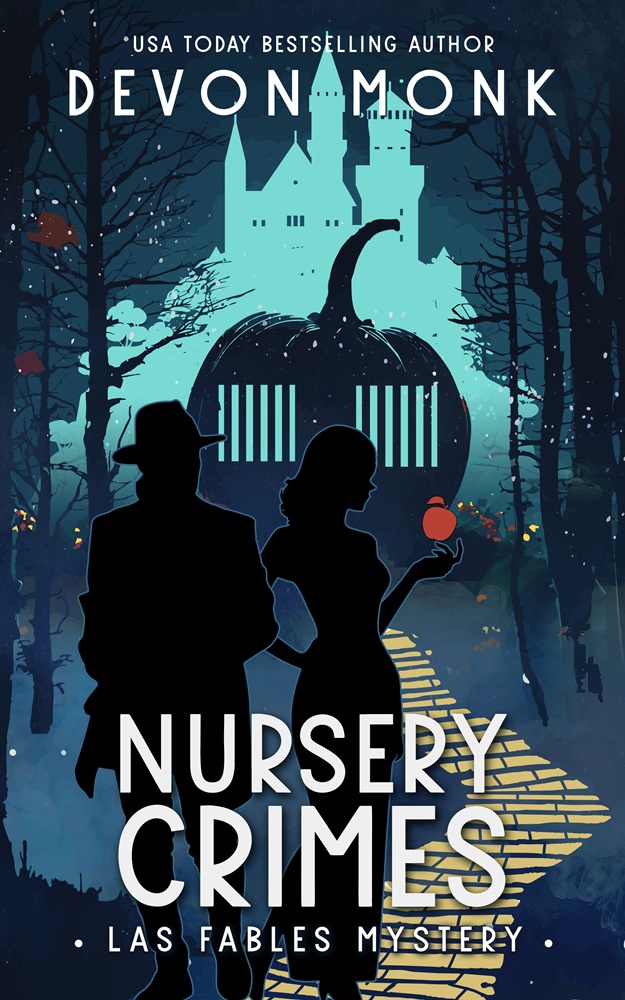
This is the city of Las Fables. I work here. I’m Detective Peter Peter. I put ‘em in the pumpkin shell.
Las Fables is a land of fairy tales and rhymes. Sure, it used to be made of sugar and spice, but Mother Goose flew the coop and hasn’t been seen in years. Darkness has settled over the town, whiffling and galumphing down the yellow brick lanes.
When the Seven Dwarves are gunned down in the Old Woman’s Shoe Bar, Detective Peter Peter and his partner Jack Horner are on the case. No matter how over the hill and far away the clues take them, they’ll see that justice is served–not too hot, not too cold, but just right.
Of course it isn’t just crime on Peter Peter’s mind. There’s a dame named Muffet who’s got him in a tizzy. And it’s gonna take all of his willpower to keep his heart from tumbling down after her.
Amazon Apple Barnes and Noble KoboYes! Nursery Crimes is a short, fun standalone book set in the storybook land of Las Fables. I am so excited to finally get to share it with you! Just like the description says, it’s a smashup: hard-boiled mystery, fairy tales, nursery rhymes, and lots and lots of ridiculous jokes.
I hope you enjoy! (print will be available soon!)
Mining Our Characters’ Wounds
While we can certainly be forgiven for not seeing our personal wounds as jewels, our most powerful wounds often have as many facets and hidden depths as an exquisitely cut gemstone. They are sharp, with hard edges that not only reflect back light but distort it somewhat.
As writers, we know that our character’s wounds are some of the most fertile ground for creating a rich, fully realized protagonist. But before we can explore this with our characters, we have to understand it ourselves. And because we have all been wounded in some way—and those places are always tender—it can be uncomfortable to look too closely.
In order to use our characters’ wounds to full effect, we need to understand that wounds aren’t simply an attribute to be filled in on a worksheet. They are the rocket fuel for our character’s backstory, the backstory that drives their motivation and colors their world. It must be deeply organic to that character and so intricately woven into their emotional DNA that it distorts the way the see the world and themselves.
While everyone’s wounds are uniquely theirs, they are also universal in that they’re something we all share. What differs is their nature, how we carry them, and the many—often unexpected—ways they shape us and our behavior.
Because of course the impact of any given wound isn’t limited to that initial injury. I was reminded of that last week when I was out walking and twisted my ankle. It was nothing serious, but by the time I’d limped around favoring it for a day or two, everything else was out of whack as I contorted my body to accommodate the injury.
Emotional wounds are just like that, only worse by orders of magnitude.
Even when we know our character’s painful past, we often don’t use it to full effect. We don’t manage to weave into the very essence of who our character is—because make no mistake, wounds fundamentally shape us, especially those incurred in childhood when we are so defenseless. With wounds of the heart or soul—the ones that violate some deep fundamental part—it is the repercussions of that initial wound that create the most scarring. The blame, the self-doubt, the suffocating shame, all serve as a way to cut us off from our core self.
Emotional neglect, a betrayal, a rejection, a lie, are all painful enough, but often become the lens through which we see ourselves. We accept that rejection. Believe that lie. Justify the betrayal due to something fundamentally flawed within us rather than the betrayer. Or worse, we don’t see it as a betrayal at all, but simple evidence of how flawed and unlovable we really are.
The emotionally abandoned child believes they are undeserving of love.
The abused believes they deserve the abuse, that love will always hurt and often comes coated in shame.
The child of addicts learns to fundamentally mistrust the safety and stability of the world around them.
The child raised in a religion that vilifies all human behavior will inevitably see themselves as sinful and unworthy.
Any kind of abuse—emotional, physical, sexual—is often the starting point for a long, twisted, distorted journey from our true selves. And our worldview takes shape around that bad information we’ve deduced because of it.
One of the biggest challenges we face as writers is how to hook our reader emotionally and forge a connection in those first few pages without becoming the literary equivalent of the stranger in the checking line, blurting out every gory detail of the drama of their lives without even having been asked.
The secret, I think, is to show or hint at the character’s contortions and defense mechanisms that have sprung up around that deeper wound. As readers, we’re trained to look for clues and hints, so we’ll spot those coping mechanisms and be intrigued—we’ll want to know why.
So as writers, we need to ask ourselves: In what ways does our character limp through the world? How do they favor that wounded place inside? What distorted belief do they cling to with both hands? What ways do they disassociate from parts of themselves that brush too closely to that wound? In what ways do they wear their wound like a chip on their shoulder, insisting to the world it has made them tough, impervious to future wounding?
And why are these characters indelibly scarred by these events, when others might brush them off or take them in stride?
I believe the answer to that last question is that because for some, the psychic soil has been well prepared and cultivated—their soil broken down and covered in so much manure before the wound even shows up—that the individual is supremely susceptible to the final blow.
But what about characters who don’t have a tragic or traumatic event in their past? What about lesser, garden variety wounds? The kind we acquire from the simple life lessons of growing older or growing up? Because the majority of the time, these shaping wounds are incurred early in life—either in our childhood, teen, or early adult years.
These less traumatic experiences still shape us, although to what degree will vary widely from character to character and will depend on things like the psychic equivalent of adrenaline, momentum, individual pain thresholds, and how cultivated the soil was.
We all have memories from our childhood, of playing with other kids, either on the playground or in the neighborhood, then taking a fall, skinning our knee or scraping an elbow. Chances are we bounced right up and kept on going, utterly impervious to any pain. At least until it was time to come inside and wash up for dinner. THEN we could feel that sucker throbbing and stinging.
Science has also shown that pain thresholds within the same person vary depending on how stressed our systems are. When we are under chronic stress, our body produces a lot more of some chemicals and fewer of others. The reformulation of our brain chemistry intensifies pain response—both physical and emotional.
So even if the story you’re writing does not involve characters with large traumatic wounds in their past, common everyday wounds can be equally fertile ground for deepening character.
- Why does a character have a gambling problem?
- A shopping addiction?
- Why are they terrified of clowns? Cats? Blimps?
- Why do they feel the need to be perfect?
- So competitive?
Each of those behaviors could be fueled by either a traumatic wound or a common every day one. It is the tone and theme of your story that will decide which it should be. Or rather I should say, it is the nature of your character’s wounds that will determine the tone and theme of your story.
We are often our own worst enemy—there is no denying that. Many writers feel that their character is his own antagonist, and that is likely true. Our desperation to avoid acknowledging our wounds, to avoid awakened that old pain and our deeply held beliefs about the nature of that pain are often an enormous component of getting in the way of our own happiness. It is hard and scary to look that deeply inside and reorient our world view, even it if ultimately frees us. It is scary to be thrust back into the same powerlessness and vulnerability we had in that moment. That is why we need stories to show us how.
Some of our character’s most transformative moments will come from facing those wounds, freeing themselves from the weight of them, and beginning the healing process. And of course, the stories we write aren’t about the wounds—but how we can overcome them.
We need stories to show us that being wounded or broken doesn’t lessen our character’s—or our own—humanity in any way. It is, in fact, what make us deeply human. The best stories show us that having been wounded doesn’t mean we are less than, or broken beyond repair, or unworthy. Instead, they illuminate all the different shapes wounds can take and the many different paths to healing that await us, if only we have the courage to look.
Do you know your character’s defining wounds? Can you brainstorm three to four ways these wounds create behaviors that readers can see on the page?
(Originally published on Writer Unboxed April 13, 2018)
IGNITING DARKNESS–Coming June 2, 2020
Hoping to find an ally from the convent, Sybella instead discovers yet another initiate who has been misled and misused by the former abbess of Saint Mortain. But with long held secrets exposed and allegiances revealed, Sybella must form an uneasy trust borne of desperation to combat enemies at the French court who would have them branded as traitors and heretics.

Some mistakes cannot be fixed—that is Genevieve’s growing fear. Though she may have been a fool, she is no coward and will do whatever it takes to set things right and ensure her Queen’s—and Sybella’s—safety. It will take all of Genevieve’s strength of will and cunning, along with Sybella’s willingness to embrace her growing power. But even that may not be enough.

Plans fail, fragile loyalties are tested, and bridges burn in this riveting conclusion to the Courting Darkness duology. Here, the Daughters of Death finally embrace the full depth of their power—and try to make whole that which has been broken, including themselves.
Want to read more? You’re in luck! My publisher is providing an e-sampler of the first eleven chapters. I hope you have as much fun reading it as I did writing it! (And if you get so excited that you feel like pre-ordering the book–be sure to save your receipts! There will be a pre-order gift. Details coming soon!)
The Charbonnerie and the Dark Mother
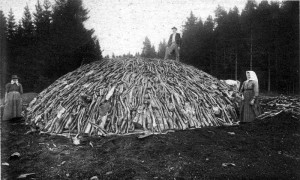 As I wrote Dark Triumph, I wanted to be sure and populate the book with some of the colorful characters from the Middle Ages that I had come across in my research, and yet it had to feel organic to the story and not wedged in there.
As I wrote Dark Triumph, I wanted to be sure and populate the book with some of the colorful characters from the Middle Ages that I had come across in my research, and yet it had to feel organic to the story and not wedged in there.
As Sybella and the wounded knight were racing through the countryside, trying to escape pursuit, I had to do some serious thinking as to who they would actually run in to, and of those people, who would help, who would hinder, and who would turn them in in a heartbeat for a reward. Since they would need to slip into the forest to evade capture, I decided to draw from those who lived in the forests or obtained their livelihood from the woods, and settled upon a group of charcoal burners.
Oddly, it is often the outcasts in society who are most accepting of other outcasts. Their very disenfranchisement sometimes makes them more willing to challenge the status quo or thumb their nose at rigid authority. While charcoal burners were not (probably) true outcasts, they did keep to themselves somewhat, confined by their livelihood to dwelling in forests and tending their charcoal fires rather than living in cities or villages.
In the middle ages, one of the most efficient fuels at the time was charcoal. Coal itself was rare and difficult to mine with their technology, but charcoal could be made through the slow burning of wood, then stopping the process before the wood was fully burned to ash. Charcoal burning was a tricky thing, requiring fairly esoteric knowledge of how to build the fire pits just so, how to pile the wood so it wouldn’t burn too quickly, and how to read the smoke to discern when the charcoal was ready. There were a number of occupational hazards, primarily involving collapsed fire pits and burns. It was also an occupation full of hazard, for a stray spark or ember could start a conflagration in minutes.
As I continued to research charcoal burners, I came across a curious mention of the Carbonnari, a branch of Italian charcoal burners. They started off as a guild, as many medieval trades did, and developed into an organization or brotherhood similar to Freemansons, only with their charcoal burning trade being at the center of their rituals and organizations. While their organization and political involvement was most evident in 19th century Italy, it is believed the groups’ origins began in the middle ages. When I learned they had a French counterpart called the Charbonnerie, I knew I’d found my outcasts.
As a writer, a dozen questions immediately went off in my mind. Who were they? What would compel them to become political and engage themselves in the affairs of the kingdom? How would they make those decisions? And, most importantly in a world populated with patron saints, whom would they worship?
Any deviation from normal church doctrine in the middle ages was rigorously opposed, so it made sense to me that they would worship someone not approved by the church, one of the older gods who’d not make the transition to patron saint.
Dovetailing nicely with this was my personal fascination with the concept of the Black Madonna. There are various theories for the origin of the Black Madonna, whether it was simply the color of Jesus and Mary’s skin before Renaissance artists reimagined them as fair skinned and blonde, or an origin that spoke to possible African roots. There is some speculation that the huge popularity of the cult of the Virgin Mary in the middle ages was a redirecting of earlier earth/mother goddess worship.
But interestingly, over the years I’d also run into mentions of the Black Artemis, rumored to have been worshipped by the Amazons, or Black Demeter, the aspect of the earth goddess when she was in deep mourning for her daughter Persephone. I took all those threads and swirled them around until I had the Dark Matrona, the unsanctioned aspect of Dea Matrona, the former earth goddess now patron saint. I decided that her darkness would be of a more spiritual nature, not unlike the Egyptian god Osiris, for in the Egyptian pantheon, black was not only the color of the underworld, but regeneration as the rich dark silt from the Nile river allowed them to grow their crops each year, and so black was also the color of regeneration, which dovetailed nicely with the book’s themes of finding hope in the darkness.
HFA Refresher: The Mythology of the Nine
While the Nine Old Gods of Brittany are my own invention, they were built on a number of historical, geographical, and ancient theological precedents, so I thought I’d share some of those here for those of you who are curious to know what my inspirations for world of His Fair Assassin were.
As the Catholic Church struggled to gain acceptance among people who were reluctant to let go of their own pagan beliefs, it made a conscious decision to actively subsume those beliefs into Christianity, white washing and Christianizing them along the way. They felt it would make it easier for people to accept the new religion if they could recognize parts of their old beliefs in it.
Brittany was also home to the last remaining group of druidesses, called the Gallinezae, who were said to possess mysterious power. Additionally, Brittany had nine bishoprics, or districts, that were based on the nine earlier Celtic tribes who inhabited the land.
Since Brittany was originally inhabited by the Celtic tribes, I built the mythology of His Fair Assassin on a Celtic foundation. It’s also important to note that I drew from Continental Celtic roots for my mythology rather than the Irish Celts.
Trying to accurately recreate any Celtic beliefs is tricky however, because the Celts themselves did not create any written record of their beliefs or practices; it was all passed along through the oral tradition. In fact, druids in training were required to study for twenty years in order to learn all their lore and history by committing it to memory.
Consequently, nothing of the Celtic religion or spiritual beliefs and practices was written down until they were invaded by Rome. In addition to viewing the Celts practices with scorn, the Romans often interpreted other pantheons according to their own, thus a mother goddess must be equated with Zeus’s wife Hera, or a god of the Underworld with Hades, etc. This Interpretatio romana colored everything we knew about Celtic practices up until fairly recently when improved archaeological techniques and methods began revealing a more complete and accurate picture. The funny thing is though, by the middle ages the myth and folklore of these earlier Celts would have been very much written over and ‘tainted’ by the Romanization of those myths, so that those living in the 15th century would have been more familiar with this Romanized version. Since I set the story in that timeframe, I wanted to be true to that worldview rather than our own, more knowledgeable one.
Here is a list of the Nine Old Gods of Brittany along with their Roman/Greek or Celtic influences/inspiration:
Saint Mortain – god of death. The Celtic equivalent to Dis Pater, the Romanized Celtic god of death, with some similarities to the Welsh Arawn. Greek and Roman counterparts would be Pluto and Hades, but the Celtic Dis Pater had other aspects to him that tied him to older beliefs that enveloped not only the underworld, but the entire cycle of life and death. Also inspired by the Breton figure of personified death, the Ankou.
Dea Matrona – Gaulish mother goddess, responsible for the earth’s bounty. Similar to the Celtic Anu or Ana.
Saint Amourna – daughter of Dea Matrona and one of the twin goddesses of love. Amourna is the gentle aspect of love. The Celtic pantheon had no goddess of love per se, so she definitely has aspects of Aphrodite or Venus. However, the idea of twin sister goddesses representing the dual aspects of love was my own invention.
Saint Arduinna – daughter of Dea Matrona and goddess of love’s sharp bite, protector of virgins. There was a Celtic goddess Arduinna who was a goddess of the forest. Boars, highly revered by the Celts, were sacred to her. Similar to the Gallo-Roman Diana.
Saint Mer – goddess of the sea. While there is no known Celtic god of the sea, there were many deities of springs and lakes, most of whom were goddesses so I decided to make the deity of the sea in my world in keeping with the feminine representations the Celts seemed to favor.
Saint Camulos – god of battle and warriors. Wears a corona of oak leaves and ram’s horns. The Romans equated him with Mars, but I also drew slightly on the cult of Mithros.
Saint Brigantia – goddess of wisdom; brought medicine and healing knowledge to mankind. Based on the Celtic goddess Bridget, who is one of the most widely known pagan goddesses to have become a saint. Her Greek and Roman counterparts would be Athena and Minerva.
Saint Cissonius – god of crossroads and travelers. I took the Celtic Cissonius, god of trade, and expanded on it a bit.
Saint Salonius – god of mistakes and patron saint of bastards. Ah, this is my most historically tenuous god. I have always been a fan of the trickster god who appears in so many pantheons, and I saw a fleeting entry on the Wikipedia Celtic Gods and Goddesses page that reference Salonius, god of mistakes. Alas, when I later went to reference it, the entry was gone and I couldn’t even find it in the Google cache search. Although it seems fitting that my god of mistakes might have been born of one of my own.
HFA Refresher: Anne of Brittany
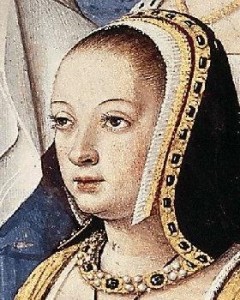 Anne of Brittany was a real historic person. At twelve years old, upon the death of her father, she inherited one of the last remaining duchies in Western Europe. By all accounts, she was a remarkable girl. Groomed since birth to inherit the duchy, she was reading and speaking Greek and Latin by the time she was five years old.
Anne of Brittany was a real historic person. At twelve years old, upon the death of her father, she inherited one of the last remaining duchies in Western Europe. By all accounts, she was a remarkable girl. Groomed since birth to inherit the duchy, she was reading and speaking Greek and Latin by the time she was five years old.
Her substantial inheritance was complicated by two things. One, she was a woman at a time when traditionally women did not inherit kingdoms. Since the time of Charlemagne, Salic Law had been invoked to prevent women from becoming rulers. When Anne became Duchess of Brittany, it defied all the conventions of that time. Secondly, and perhaps more importantly, not only was she unmarried, but her father had promised her hand in marriage to at least half a dozen European nobles, if not more. As he plotted and strategized, trying to keep his lands and title safe from the French Crown, he dangled his daughter (and her substantial dowry) as bait for the aid he needed from other princes and dukes. Consequently, when he died, she had been promised to more than one suitor.
To say that this created problems for her in keeping her duchy independent is an understatement. Which is why she needed the help of assassin nuns. What? Doesn’t everybody call for assassin nuns when they’re having political difficulty? If not, they should….
HFA Refresher: Legends of Brittany
In preparation for the publication of COURTING DARKNESS, and because I realize not everyone has time for a re-read of the original trilogy, I thought I would put up some “refresher” posts to help readers reacquaint themselves with the His Fair Assassin world before diving back in. First up: the legends and folklore of Brittany that planted those first seeds in my imagination, lo those many years ago . . .
As I combed through history, looking for the perfect setting for this story, four things caught my attention and eventually solidified into the world of His Fair Assassin. The first was a twelve year old duchess who inherited a kingdom, that inheritance hugely complicated by the fact that she had been promised in marriage to half a dozen princes and nobles.
Next was a mention of the Gallizenae, nine druidesses who lived on the Ile de Sein off the coast of Brittany and possessed mysterious powers.
While Googling for images of the Ile de Sein, I came across of photo of a small, medieval chapel standing next to one of the old, pagan standing stones that are so plentiful in Brittany. It was such a vivid illustration of one of the things that has always fascinated me—how the Catholic Church was so successful at absorbing bits and pieces of the older, ancient religions.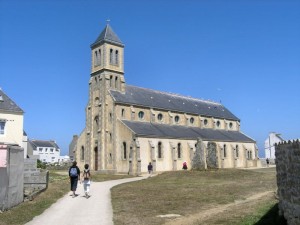
I also learned of a Breton folklore figure call the Ankou, a personification figure of Death.
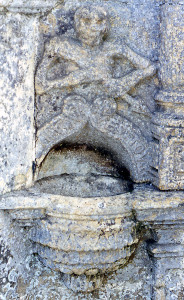
Then lastly, I read about the Passage de l’Enfer—a Breton folktale of fisherman who receive a knock on their door at midnight and were required row the souls of the dead across the ocean at night. Those legends soon became intertwined in my mind and the story idea began to take shape . . .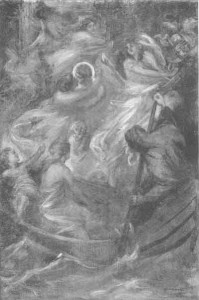
FAQ: Do I Need To Read The HFA Trilogy Before Reading Courting Darkness?
I get asked this a lot, so thought I’d try to address it here.
Courting Darkness is meant to be able to be read without having read the original His Fair Assassin trilogy. But it is not the first book of Sybella’s adventures.
If you read an ARC and were lost—I’m sorry. That is one of the absolute downsides to ARCs—they are unfinished and sometimes relatively unpolished copies. I made THREE more rounds of line edits after the ARCs were printed. A large portion of those changes were to help make Courting Darkness more accessible to new readers and help bring former His Fair Assassin readers up to speed.
I think we succeeded in making it less confusing to new readers. But part of that depends on what sort of reader you are.
Some readers hate to read reviews or synopsis and love trying to piece together the backstory from context clues. Others like every detail spelled out and like a lot of explanation in the narrative. There are definitely readers who hit Courting Darkness cold and thoroughly enjoyed it! Where exactly their reader preferences fell on the above spectrum, I’m not sure.
Part of the problem as a writer was finding a way to revisit the events of Dark Triumph without utterly violating who Sybella is as a character. She is an extraordinarily private person whose past was so difficult that she blocked out most of it for four years. Those early memories will never be something she takes out causally to mull over. To have her do so felt like it cheapened her experience, turning it into something exploitative, even though it would have filled readers in on what had happened in her past. But honestly, I think those experiences of hers will mean more if they are experienced with her rather than recounted in a narrative recap.
So I believe (hope?) you can read Courting Darkness first. With luck, you will enjoy it enough that you’ll want to know more about Sybella and give Dark Triumph a try—it will answer so many questions you might have! But it is very likely that reading Courting Darkness will be a richer experience if you’ve read the trilogy first. But if you haven’t, don’t despair! Sybella’s full backstory will be revisited more fully in the second book in the duology—when events give her no choice but to confront it.
Nine Worlds Convention London
(LATE) ME ALERT!!!
I’ll be attending Nine Worlds this weekend since I had such awesome fun there last time. I’ll be there on the Friday and Sunday, but not Saturday as some friends of mine have inconveniently decided to get married right in the middle of the year’s greatest geekfest! Don’t people check their calendars anymore? *eyeroll*
Schedule:
FRIDAY 10 am (bright and early): Megan Leigh (Breaking The Glass Slipper podcast) interviews little old me about all kinds of stuff! Signing at the Big Green Bookstore stand right after.
6:45 pm – Twisted Tales: a panel about the darker side of fairytales
SUNDAY
1:30 pm Things You Never Thought Could Be: a panel about YA fiction.
For more info click here and type ‘Wooding’ in the search field.
When I’m not in panels I shall very likely be in the bar, er, ‘networking’ or in the gaming room nerding out on all the boardgames I can find all at once. Also I use conventions as an opportunity to hunt down potential rivals and assassinate them, so if they’ve written a good book in the last year or so and they’re at Nine Worlds, they’re probably on my list.
THE EMBER BLADE!!!
At last! All is revealed! Here is the doorstopper I’ve been working on all this time. Release date 15th February 2018. Available for preorder now. All the info here.



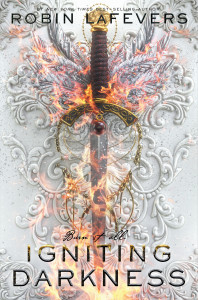
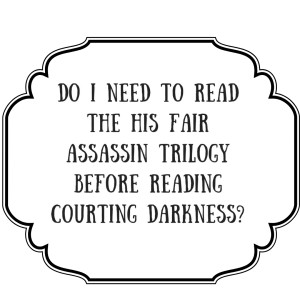
Recent comments